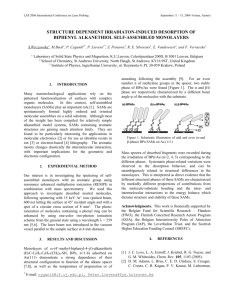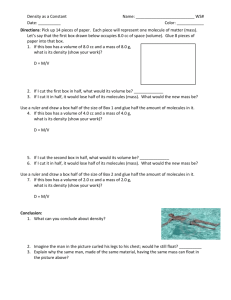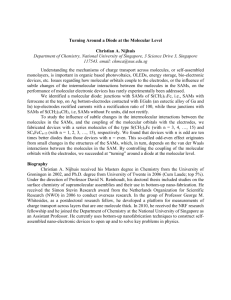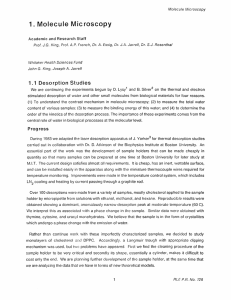Particle-induced desorption of biphenyl alkanethiol and
advertisement
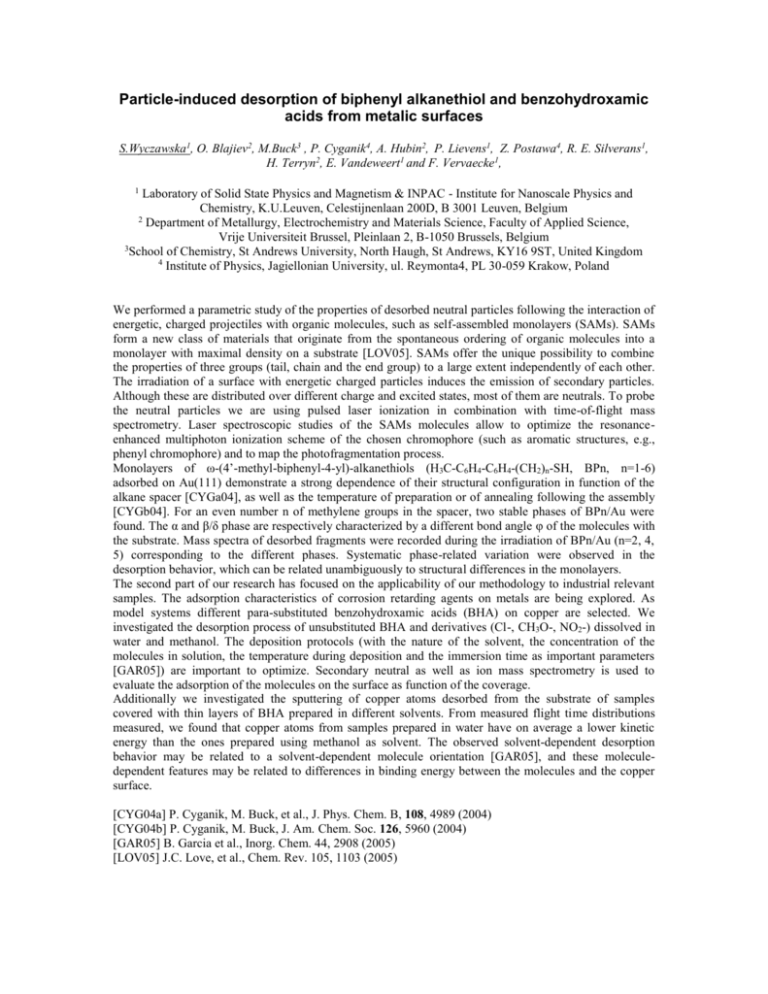
Particle-induced desorption of biphenyl alkanethiol and benzohydroxamic acids from metalic surfaces S.Wyczawska1, O. Blajiev2, M.Buck3 , P. Cyganik4, A. Hubin2, P. Lievens1, Z. Postawa4, R. E. Silverans1, H. Terryn2, E. Vandeweert1 and F. Vervaecke1, 1 Laboratory of Solid State Physics and Magnetism & INPAC - Institute for Nanoscale Physics and Chemistry, K.U.Leuven, Celestijnenlaan 200D, B 3001 Leuven, Belgium 2 Department of Metallurgy, Electrochemistry and Materials Science, Faculty of Applied Science, Vrije Universiteit Brussel, Pleinlaan 2, B-1050 Brussels, Belgium 3 School of Chemistry, St Andrews University, North Haugh, St Andrews, KY16 9ST, United Kingdom 4 Institute of Physics, Jagiellonian University, ul. Reymonta4, PL 30-059 Krakow, Poland We performed a parametric study of the properties of desorbed neutral particles following the interaction of energetic, charged projectiles with organic molecules, such as self-assembled monolayers (SAMs). SAMs form a new class of materials that originate from the spontaneous ordering of organic molecules into a monolayer with maximal density on a substrate [LOV05]. SAMs offer the unique possibility to combine the properties of three groups (tail, chain and the end group) to a large extent independently of each other. The irradiation of a surface with energetic charged particles induces the emission of secondary particles. Although these are distributed over different charge and excited states, most of them are neutrals. To probe the neutral particles we are using pulsed laser ionization in combination with time-of-flight mass spectrometry. Laser spectroscopic studies of the SAMs molecules allow to optimize the resonanceenhanced multiphoton ionization scheme of the chosen chromophore (such as aromatic structures, e.g., phenyl chromophore) and to map the photofragmentation process. Monolayers of ω-(4’-methyl-biphenyl-4-yl)-alkanethiols (H3C-C6H4-C6H4-(CH2)n-SH, BPn, n=1-6) adsorbed on Au(111) demonstrate a strong dependence of their structural configuration in function of the alkane spacer [CYGa04], as well as the temperature of preparation or of annealing following the assembly [CYGb04]. For an even number n of methylene groups in the spacer, two stable phases of BPn/Au were found. The α and β/δ phase are respectively characterized by a different bond angle φ of the molecules with the substrate. Mass spectra of desorbed fragments were recorded during the irradiation of BPn/Au (n=2, 4, 5) corresponding to the different phases. Systematic phase-related variation were observed in the desorption behavior, which can be related unambiguously to structural differences in the monolayers. The second part of our research has focused on the applicability of our methodology to industrial relevant samples. The adsorption characteristics of corrosion retarding agents on metals are being explored. As model systems different para-substituted benzohydroxamic acids (BHA) on copper are selected. We investigated the desorption process of unsubstituted BHA and derivatives (Cl-, CH3O-, NO2-) dissolved in water and methanol. The deposition protocols (with the nature of the solvent, the concentration of the molecules in solution, the temperature during deposition and the immersion time as important parameters [GAR05]) are important to optimize. Secondary neutral as well as ion mass spectrometry is used to evaluate the adsorption of the molecules on the surface as function of the coverage. Additionally we investigated the sputtering of copper atoms desorbed from the substrate of samples covered with thin layers of BHA prepared in different solvents. From measured flight time distributions measured, we found that copper atoms from samples prepared in water have on average a lower kinetic energy than the ones prepared using methanol as solvent. The observed solvent-dependent desorption behavior may be related to a solvent-dependent molecule orientation [GAR05], and these moleculedependent features may be related to differences in binding energy between the molecules and the copper surface. [CYG04a] P. Cyganik, M. Buck, et al., J. Phys. Chem. B, 108, 4989 (2004) [CYG04b] P. Cyganik, M. Buck, J. Am. Chem. Soc. 126, 5960 (2004) [GAR05] B. Garcia et al., Inorg. Chem. 44, 2908 (2005) [LOV05] J.C. Love, et al., Chem. Rev. 105, 1103 (2005)
